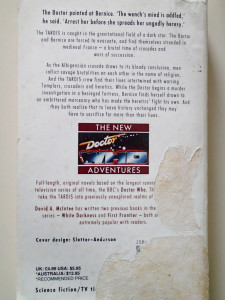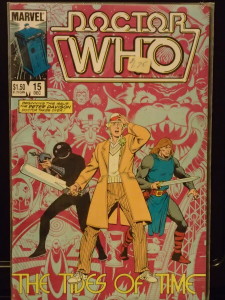In case you are not aware, November 23, 2013 will mark the 50th anniversary of Doctor Who. There are a lot of articles out there commemorating the occasion, but I wanted to do something different. This article series is about my experience of growing up as a Doctor Who fan in America in the 80s and 90s. It was definitely an interesting experience being a foreign fan of something that is so British and watching it go from being a cult weirdo thing to a celebrated part of modern geek culture.
Doctor Who is, at its core, a television show about one man’s adventures traveling through time and space. If you are unfamiliar with Doctor Who, I suggest you read a primer I wrote about the program.
Or, if you like, watch this vintage PBS telethon documentary:
Once you are up to speed, I will now take you on an adventure in time and space. First, we will go back to…
December 23rd, 2012 A.D. Newbury Comics, Cambridge, Massachusetts, USA
It was a crisp December 23rd in Harvard Square, which is located just outside the grounds of Harvard University. It is full of interesting shops, bars and restaurants and I spent quite a lot of time there when I was growing up down the road in Watertown. I now live in Seattle with my wife and daughter and we had come back to visit my parents for Christmas. I had just seen some old friends for lunch while my wife was in Boston exploring the Museum of Fine Arts. I took advantage of the after-lunch opportunity to get a couple of small Christmas presents.
I went with my friend A.J. into Newbury Comics. Newbury Comics is a Boston institution. It started out as a comic book and punk rock record store on Newbury Street in downtown Boston and expanded across the region. Their music selection can’t be beat and has long been one of those stores where its clientele, most of whom are under 30, can get “cool” stuff.
When we went in there, I couldn’t believe what I was seeing.

There was a massive section of the store given over to Doctor Who merchandise- TARDIS tchotchkes, action figures, talking Daleks, and Doctor Who-themed knee socks.

“Where were the girls traipsing about in TARDIS knee socks when I was in high school?” I somewhat jokingly lamented to A.J.
Nearly all of the merchandise was Eleventh Doctor-related. The last time I had been in the store, which had been about 2 years previously, they also had Doctor Who stuff, but it was a couple of rows of action figures and some sonic screwdrivers in a corner. But this display- this was pretty huge was angled so it could be seen by anyone who entered the store.
Then it hit me. Doctor Who was…cool? This was one of those things that I thought I would never see. I have been a Doctor Who fan since I was a young child and experienced a lot of teasing, ribbing and joshing over the years for liking such a strange TV show. The last thing I ever thought it would be was “cool.” Given the evidence in front of my eyes, it was definitely cool enough amongst the kids of today for the managers of this particular Newbury Comics to devote a large amount of floorspace to Doctor Who merchandise.
Doctor Who is celebrating its 50th anniversary in November 2013, and it is as popular worldwide as it has ever been. The original series was on the air from 1963-89. It was started up again in 2005 with a much larger special effects budget and has received much critical acclaim. It has become so popular now that the 50th anniversary episode has been filmed in 3D and will be shown in theatres across the world. I already have two tickets to a screening in Seattle, but nobody to go with me yet, which sort of sums up my experience of Doctor Who fandom.
Doctor Who has meant a lot to me over the years, but it has been, for the most part, a private devotion. That’s not to say I haven’t tried to share it, but it is something that is, most certainly, an acquired taste for most people. Let’s put it this way- just about everyone I know thinks that Doctor Who is really weird. For me, it was just something that I have loved for as long as I can remember…
Early 1980s, Watertown, Massachusetts, USA
It was 7:00 PM on a weekday evening, and my father and I (presumably at least 4-5 years of age) were sitting on the floor in the living room in front of the TV, which was tuned to WGBH Channel 2, the Boston PBS station. My father is a sci-fi fan himself, so I don’t know if he intended to watch it that night with me or not, but Episode 1 of “The Ark in Space” appeared on the screen…
It was the awesomest, coolest, scariest thing that I had ever seen on TV and I was forever hooked. Doctor Who’s format during the original run of the series (1963-89) was a single story broken into 25-minute episodes with a cliffhanger at the end. Most of the stories were broken into 4 or 6 episodes. In England, they were shown on Saturday evenings, but when they were re-run on Channel 2 in the late 1970s-late 1980s, they showed one episode every weeknight. Needless to say, if you come in during the middle of a story, it can be a bit confusing. “The Ark in Space” finds the Doctor (played by Tom Baker, the Fourth Doctor) and his friends landing on what seems to be an abandoned space station…
While Doctor Who has a rich history in England, it gained a foothold in the US in the early 1980s when PBS stations played the Tom Baker episodes over and over and over again. Before the new series began, if you asked an American if they knew who Doctor Who was, they would mention something about the guy with the long scarf and the afro and the song: “Wooo-eeee-ooo!”
As a child, I found the episdoes featuring the Tom Baker Doctor scary, weird and funny- exactly what you want out of a TV show character at that time in your life. The special effects of the original series have always been rightly derided (you try to make 14-45 episodes of sci-fi TV/year on a TV channel funded by taxpayers look realistic without the aid of computers!), but to a kid who was willing to suspend his disbelief, they were absolutely perfect.
There were times though where I got a bit too scared and stopped watching for awhile. Once, when I got the courage to watch it again, I got the surprise of my life when I found that they had started showing episodes featuring a completely different actor playing the Doctor!
The only clues that I had to prove it was the same show were the theme song, the name of the show of course, and the “Tartus” (AKA the TARDIS, the Doctor’s blue box) appearing in the background.
Right away I found the new Doctor with the ruffled shirt (the “Third Doctor,” played by Jon Pertwee) was better than the “Scarf Doctor.” For one thing, it was just as scary and exciting, but there was more action- the Doctor even would get in fights once in a while (I am an American, after all)!
Then, inexplicably, Sarah Jane Smith, who had travelled with the Scarf Doctor showed up! Then the Ruffled Shirt Doctor went to the “Planet of the Spiders” and died and then came back to life- as the Scarf Doctor! I was totally confused, but pressed on nonetheless.
Eventually, they started showing new Scarf Doctor episodes that I had never seen before. Then, the Master, the Doctor’s archenemy from the Ruffled Shirt days, came back but another actor was playing the part. He and the Scarf Doctor fought and then Scarf Doctor died and came back as a young blonde guy!
Even though I was ready for the change but it was still pretty jarring. I quickly grew to love the Blonde Doctor (the “Fifth Doctor,” played by Peter Davison) as much as I loved the others- what was even cooler was the realization that these were brand new episodes- they were still making Doctor Who in England!
Fall 1985, Downtown Crossing, Boston, Massachusetts, USA
By the time I saw the Blonde Doctor episodes, I had been watching Doctor Who for at least half my life at that point, but I knew very little about it. About this time I started going with my mother into downtown Boston on the T (Boston’s subway) for shopping trips to Filene’s and Jordan Marsh department stores.
On one of these trips, out of the corner of my eye, I saw pictures of Superman, Batman, Spider-Man and the Incredible Hulk in a random third-story window. I begged and begged my mother to take me up there. Despite my mother’s fear that we were going to be mugged in the stairwell going up to the third floor, she took me into Superhero Universe, my first comic store.
Having been used to comic racks at drugstores, I was completely blown away that there was an entire store that sold only comic books. I have always been more of a Marvel comics fan, and I had noticed in my reading that they were advertising a Doctor Who comic book but I could never find it on the racks. I asked the Comic Book Guy if he had any issues, and he had all of them! I got a forward on my allowance to pick up Doctor Who #15, which featured the first part of a new story with the Blonde Doctor. As if that wasn’t awesome enough, the back of the comic had articles about Doctor Who! It was like a message in the bottle for me. Up to this point, I had no idea that Doctor Who was anything other than a TV show. A whole new world was about to open up for me…
Find out the exciting conclusion in Part 2 of Adventures of an American Whovian!




